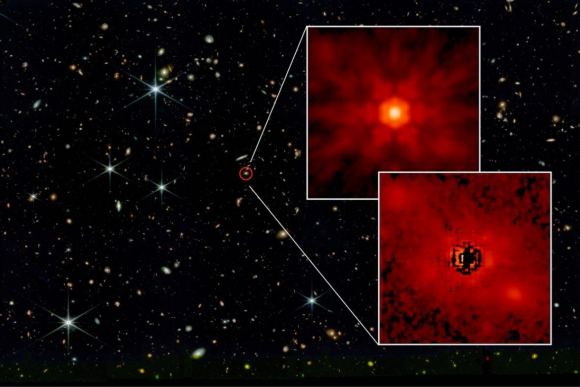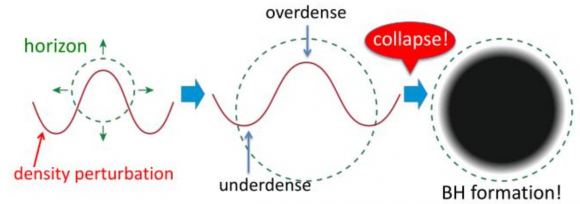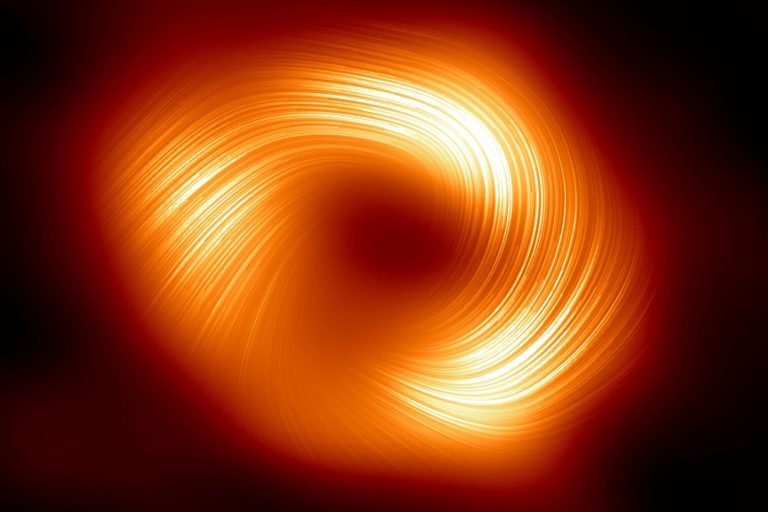How Dark Matter Fueled the Growth of Early Supermassive Black Holes
Dark matter may have played a crucial role in the rapid formation of supermassive black holes (SMBHs) in the early Universe. Recent findings by the James Webb Space Telescope (JWST) have uncovered SMBHs existing just 500 million years after the Big Bang, challenging previous understandings of black hole formation. The influence of decaying dark matter particles may have prevented the fragmentation of hydrogen clouds, allowing them to collapse and form these colossal structures in the early Universe.
Summary
- Discovery of supermassive black holes in the early Universe by the JWST.
- SMBHs in the early Universe challenge existing black hole formation theories.
- Dark matter’s role in accelerating the growth of SMBHs.
- Influence of decaying dark matter particles on gas cloud collapse.
- Primordial black holes as a potential origin of early SMBHs.
- Population III stars and their contribution to SMBH formation.
- The role of molecular hydrogen in the cooling and collapse of gas clouds.
- Radiation from dark matter decay preventing gas cloud fragmentation.
- Potential evidence of dark matter influence seen in the Cosmic Optical Background (COB).
- Ongoing research into dark matter’s role in early Universe SMBH formation.
- Axion-like particles and their possible impact on SMBH formation.
- The need for further study to confirm these theories.
- The mysterious nature of dark matter and its various proposed forms.
- Implications of these findings for our understanding of cosmic evolution.
- The importance of the JWST in providing new insights into early Universe phenomena.
- The role of gravo-thermal collapse in the formation of early SMBHs.
- Comparison of SMBH formation in the early Universe versus later cosmic times.
- The significance of SMBHs for the evolution of galaxies and cosmic structures.
- The potential for future discoveries with ongoing JWST observations.
- The broader implications for astrophysics and cosmology if these theories are confirmed.
How Dark Matter Fueled the Growth of Early Supermassive Black Holes
The discovery of supermassive black holes (SMBHs) in the early Universe has left astronomers and astrophysicists scratching their heads. These cosmic giants, found in the active galactic nuclei of galaxies less than a billion years after the Big Bang, defy our current understanding of black hole formation and growth. The James Webb Space Telescope (JWST) has played a pivotal role in this discovery, revealing SMBHs in regions of the Universe where their existence was not expected. So, how did these massive black holes form so quickly? One of the most compelling theories points to the role of dark matter.
The Mystery of Early Supermassive Black Holes
Supermassive black holes are typically thought to form over billions of years, growing by accreting gas and dust or by merging with other black holes. The SMBH at the center of our Milky Way Galaxy, for instance, has a mass of about four million solar masses, a size that likely took billions of years to achieve. However, the JWST has identified SMBHs that already appear “old” and massive less than a billion years after the Big Bang. This is a significant puzzle because, according to conventional models, there simply hasn’t been enough time for these black holes to grow so large.
Astrophysicist Alexander Kusenko, a professor of physics and astronomy at UCLA, highlighted the surprising nature of these findings: “How surprising it has been to find a supermassive black hole with a billion-solar-mass when the universe itself is only half a billion years old. It’s like finding a modern car among dinosaur bones and wondering who built that car in the prehistoric times.”

Population III Stars and the First Black Holes
One possible explanation for the early formation of SMBHs involves the first generation of stars, known as Population III stars. These stars formed from the primordial gas that existed shortly after the Big Bang, consisting almost entirely of hydrogen and helium. Because these stars lacked heavier elements (or “metals”), they were incredibly massive, short-lived, and ended their lives in violent supernova explosions. These explosions could have left behind black holes with masses several times that of our Sun.
These initial black holes could have merged over time, eventually growing into SMBHs. However, this process still requires time—something that the early Universe didn’t have in abundance. Therefore, while Population III stars likely contributed to the formation of SMBHs, they may not fully explain the rapid growth observed in the early Universe.
The Role of Dark Matter in Black Hole Formation
This is where dark matter enters the picture. Dark matter is a mysterious substance that makes up about 27% of the Universe’s mass-energy content, yet it does not emit, absorb, or reflect light, making it invisible and detectable only through its gravitational effects. Despite its elusive nature, dark matter plays a crucial role in the formation of cosmic structures, including galaxies and black holes.
One of the theories proposed by Kusenko and his colleagues suggests that dark matter could have accelerated the formation of SMBHs in the early Universe. They hypothesize that if dark matter particles decay, they could emit radiation that influences the cooling and collapse of gas clouds. In a typical scenario, gas clouds in the early Universe cool by radiating away energy, causing them to fragment into smaller clouds that eventually form stars. However, the presence of dark matter decay products could prevent this fragmentation, allowing the gas clouds to remain intact and collapse directly into black holes.
Gravo-Thermal Collapse and Dark Matter
Another proposed mechanism involves the concept of gravo-thermal collapse within dark matter halos. This process occurs when there is a negative heat transfer within a system, causing it to become unstable and collapse. If dark matter interacts with itself, this could lead to a rapid collapse of the halo, forming a black hole at its center. Once formed, this black hole could grow rapidly by accreting surrounding gas and merging with other black holes.
This theory is intriguing because it provides a potential explanation for the rapid growth of SMBHs in the early Universe. The key factor here is the behavior of dark matter and its interaction with normal (baryonic) matter. If dark matter particles are capable of decaying and emitting radiation, they could play a significant role in the early stages of black hole formation.
Primordial Black Holes: A Possible Contributor?
Another potential contributor to the early formation of SMBHs is primordial black holes. These hypothetical black holes could have formed in the very early Universe, just moments after the Big Bang, under conditions where dense regions of space collapsed quickly. If primordial black holes existed, they could have served as “seeds” for the formation of larger black holes, including SMBHs.
The idea of primordial black holes is still highly speculative, and there is no direct evidence for their existence. However, if they did form, they could have merged with each other and with other black holes, growing rapidly into SMBHs. This theory is consistent with the discovery of SMBHs in the early Universe, but it requires further investigation.

The Influence of Molecular Hydrogen and Radiation
The formation of SMBHs also depends on the cooling of gas clouds in the early Universe. Molecular hydrogen (H2) plays a crucial role in this process, acting as a cooling agent that allows gas clouds to lose energy and collapse. However, the presence of certain types of radiation can destroy molecular hydrogen, preventing the gas clouds from cooling and fragmenting.
Kusenko and his team suggest that dark matter decay could produce the necessary radiation to prevent the cooling of gas clouds. Specifically, they propose that an “axion-like” dark matter particle could decay and emit radiation that breaks up molecular hydrogen, keeping the gas clouds warm and intact. This would create the right conditions for the rapid collapse of the gas cloud into an SMBH.
Evidence from the Cosmic Optical Background (COB)
One of the intriguing pieces of evidence supporting the dark matter decay theory comes from observations of the Cosmic Optical Background (COB). The COB is a faint glow of visible light that permeates the Universe, analogous to the Cosmic Microwave Background (CMB) but in the optical spectrum. It represents the sum of all light emitted by objects beyond our Milky Way Galaxy.
The New Horizons spacecraft, using its Long-Range Reconnaissance Imager (LORRI) instrument, has provided precise measurements of the COB. These measurements show excess light that cannot be explained by known astrophysical sources, suggesting that there may be additional, unidentified sources of radiation in the early Universe. Kusenko and his team propose that this excess light could be the result of dark matter decay, supporting their theory of dark matter’s role in SMBH formation.
The Need for Further Study
While the theory of dark matter-fueled SMBH formation is compelling, it is still in its early stages and requires further study. There are many unanswered questions about the nature of dark matter, its potential to decay, and its interactions with baryonic matter. Additionally, the formation of SMBHs in the early Universe is likely influenced by a combination of factors, including the role of Population III stars, primordial black holes, and gravo-thermal collapse.
Future observations and studies will be crucial in testing these theories and advancing our understanding of the early Universe. The JWST, with its ability to observe distant galaxies and black holes, will continue to play a vital role in this research. Additionally, other upcoming telescopes, such as the European Space Agency’s Euclid mission and the Vera C. Rubin Observatory, will provide new insights into dark matter and its role in cosmic evolution.
The discovery of SMBHs in the early Universe and the potential role of dark matter in their formation have significant implications for our understanding of cosmic evolution. If dark matter played a crucial role in the rapid growth of these black holes, it would suggest that dark matter is more complex and dynamic than previously thought. This could lead to a reevaluation of existing models of dark matter and its influence on the formation of cosmic structures.
Moreover, the study of SMBHs in the early Universe could provide new insights into the nature of dark matter and the fundamental forces that shaped the cosmos. As we continue to explore these mysteries, we may uncover new, unexpected connections between dark matter, black holes, and the evolution of the Universe.
References
Dark Matter Could Have Helped Make Supermassive Black Holes in the Early Universe
Direct Collapse Supermassive Black Holes from Relic Particle Decay
Pre-print of Paper
#SupermassiveBlackHoles, #DarkMatter, #JamesWebbSpaceTelescope, #CosmicEvolution, #Astrophysics, #EarlyUniverse, #PrimordialBlackHoles, #GravitationalCollapse, #PopulationIIIStars, #CosmicOpticalBackground

